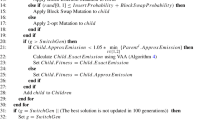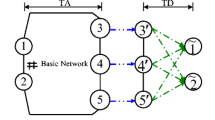Abstract
This paper proposes an estimation approach for a commodity origin-destination matrix by using a sample commodity origin-destination (OD) matrix from a Commodity Flow Survey and also mode-specific OD matrices obtained from a transportation record of freight carriers. The proposed approach is formulated as a multi-objective bi-level optimization problem in which the upper-level seeks to minimize the sum of square deviation from the target matrices, while in the lower-level, user-equilibrium assignments of commodity OD matrix from a CFS and mode-specific OD matrices are performed. The developed model and the Genetic Algorithms-based solution algorithm were validated and tested on an intermodal transportation network of Korea. The results show that the model is able to produce an acceptable commodity OD matrix, implying that the proposed approach is applicable for a real-world problem.




Similar content being viewed by others
References
Al-Battaineh, O., & Kaysi, I. A. (2005). Commodity-based truck matrix estimation using input-output data and genetic algorithms. Transportation Research Record, 1923, 37–45.
An, O., Kang, Y., & Lee, S. (2014). A study on the impact of soft location factors in the relocation of service and manufacturing firms. International Journal of Urban Sciences, Online first, doi:10.1080/12265934.2014.893834.
Beagan, D., Fischer, M., & Kuppam, A. (2007). Quick response freight manual II. Publication No. FHWA-HOP-08-010, US department of transportation, Federal highway administration.
Crainic, T. G., Dufour, G., & Florian, M., (2001). Demand matrix adjustment for multimodal freight networks. Transportation Research Record, 1771, 140–147.
Florian, M. (1984). An introduction to network models used in transport planning. In Transport planning models (pp. 137–152). Amsterdam: North-Holland.
Gedeon, C., Florian, M., & Crainic, T. (1993). Determining origin-destination matrices and optimal multiproduct flows for freight transportation over multimodal networks. Transportation Research Part B: Methodological, 27(5), 351–368.
Guelat, J., Florian, M., & Crainic, T. (1990). A multimode multiproduct network assignment model for strategic planning of freight flows. Transportation Science, 24(1), 25–39.
Holguín-Veras, J., & Patil, G. (2007). An integrated commodity based/empty trip freight origin-destination synthesis model. Transportation Research Record: Journal of the Transportation Research Board, 2008, 60–66.
Holguin-Veras, J., & Patil, G. (2008). A multicommodity integrated freight origin-destination synthesis model. Networks and Spatial Economics, 8, 309–326.
Janic, M. (2007). Modelling the full cost of an intermodal and road freight transport network. Transportation Research Part D: Transport and Environment, 12, 33–44.
Kim, H. S., (2010). A study on multimodal freight modeling: focused on container transportation in Korea. Master thesis, Department of Transportation, University of Seoul, Korea.
Kim, E., Park, D., Kim, C., & Lee, J. Y. (2012). A new paradigm for freight demand modeling: The physical distribution channel choice approach. International Journal of Urban Sciences, 14(3), 240–253.
List, G., & Turnquist, M. (1994). Estimating truck travel patterns in urban areas. Transportation Research Record, 1430, 1–9.
List, F. G., Konieczny, L. A., Durnford, C. L., & Papayanoulis, V. (2002). Best-practice truck-flow estimation model for the New York City region. Transportation Research Record, 1790, 97–103.
Nozick, L., Tumquist, M., & List, G. (1996). Trade pattern estimation between the United States and Mexico. Transportation Research Circular, 459, 74–87.
Park, D., Kim, N. K., Park, H., & Kim, K. (2012). Estimating trade-off among logistics cost, \(\text{ CO }_{2}\) and time: A case study of container transportation systems in Korea. International Journal of Urban Sciences, 16(1), 85–98.
Park, H., Park, D., Kim, C., Kim, H., & Park, M. (2013). A comparative study on sampling strategies for truck destination choice model: Case of Seoul Metropolitan Area. Canadian Journal of Civil Engineering, 40(1), 19–26.
Pattanamekar, P., Park, D., Lee, K., & Kim, C. (2009). Estimating multimodal OD matrix from mode specific OD matrices. In Origin-destination estimation and traffic modeling in networks, CD-ROM. Washington, DC: Transportation Research Board of the National Academies.
Ríos, A., Nozick, L. K., & Turnquist, M. A. (2002). The value of different categories of information in estimating freight origin-destination tables. Transportation Research Record, 1783, 42–48.
Southworth, F. et al. (2010). The freight analysis framework, version 3: Overview of the FAF3 National Freight Flow Tables. Prepared for Federal highway administration Office of freight management and operations Federal highway administration US Department of Transportation, Washington, DC.
Tamin, O. Z., & Willumsen, L. G. (1988). Freight demand model estimation from traffic counts. PTRC Annual Meeting, University of Bath, England. Reprinted in Simplified Transport Demand Modeling, Juan de Dios Ortúzar, Ed. PTRC.
Tavasszy, L. (1996). A modeling European freight transport flows, PhD Thesis. Delft, Netherland: Technical University of Delft.
Yamada, T., Russ, B. F., Castro, J., & Taniguchi, E. (2009). Designing multimodal freight transport networks: A heuristic approach and applications. Transportation Science, 43(2), 129–143.
Yoon, J., & Le, Y. (2013). Analysis of the transport efficiency of reverse logistics in Japan. International Journal of Urban Sciences, 17(3), 399–413.
Acknowledgments
This research was supported by the Basic Science Research Program through the National Research Foundation of Korea (NRF) funded by the Ministry of Education, Science and Technology (NRF-2010-0012554)
Author information
Authors and Affiliations
Corresponding author
Rights and permissions
About this article
Cite this article
Pattanamekar, P., Park, D., Lee, KD. et al. Genetic Algorithm-Based Approach for Estimating Commodity OD Matrix. Wireless Pers Commun 79, 2499–2515 (2014). https://doi.org/10.1007/s11277-014-1808-x
Published:
Issue Date:
DOI: https://doi.org/10.1007/s11277-014-1808-x




